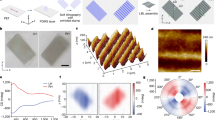Abstract
WE report here that the large platelet defects occasionally found in natural diamonds emit polarised cathodoluminescence in the near infrared. Lattice defects in natural diamonds attract as much scientific enquiry today as at any time since the anomalous ‘spike’ diffuse X-ray reflections from single-crystal diamonds were discovered1. That platelet-type defects segregated on {100} planes of the diamond matrix could well account for the ‘spike’ X-ray reflection observations1,2 was shown by Frank3. Transmission microscopy4 revealed just such platelets, with diameters generally in the range 10 to 100 nm, profusely present within the most common form of diamond (Type Ia). Mendelssohn5 described a specimen containing platelets on {100} that were more than two orders of magnitude greater in diameter than those that had become well known through transmission electron microscopy. The large platelets emitted a green–yellow cathodoluminescence which made them conspicuous when they lay not deeper below the specimen surface than the penetration range of the bombarding electron beam (∼ 10 µm). Work in our laboratory has shown that platelets on {100} span the gamut of sizes from the largest observed by Mendelssohn down to the more familiar sub-micrometre objects seen electron-microscopically. This knowledge has been acquired by combining X-ray topography (using both normal Bragg reflections and the anomalous ‘spike’ reflections), cathodoluminescence topography, ultraviolet absorption topography and transmission electron microscopy at 100 kV and 1 MeV (refs 6,7). Platelets exceding 5–10 µm in maximum dimension are rare compared with those of sub-micrometre size; but our experience affords us a good chance of identifying solely by X-ray topography regions within diamonds where there reside platelets having extreme dimensions exceeding 1–2 µm (and such platelets we dub ‘giant’).
This is a preview of subscription content, access via your institution
Access options
Subscribe to this journal
Receive 51 print issues and online access
$199.00 per year
only $3.90 per issue
Buy this article
- Purchase on Springer Link
- Instant access to full article PDF
Prices may be subject to local taxes which are calculated during checkout
Similar content being viewed by others
References
Raman, C. V. & Nilakantan, P. Proc. Indian Acad. Sci. A11, 389–397 (1940).
Hoerni, J. A. & Wooster, W. A. Acta crystallogr. 8, 187–194 (1955).
Frank, F. C. Proc. R. Soc. A237, 168–174 (1956).
Evans, T. & Phaal, C. Proc. R. Soc. A270, 538–552 (1962).
Mendelssohn, M. J. thesis, Univ. London (1971).
Hanley, P. L., Kiflawi, I. & Lang, A. R. Phil. Trans. R. Soc. A284, 329–368 (1977).
Woods, G. S. Phil. Mag. 34, 993–1012 (1976).
Clark, C. D., Ditchburn, R. W. & Dyer, H. B. Proc. R. Soc. A237, 75–89 (1956).
Collins, A. T. Indust. Diamond Rev. 34, 131–137 (1974).
Walker, J. Nature 250, 376 (1974).
Evans, T. Contemp. Phys. 17, 45–70 (1976).
Walker, J. Nature 264, 317 (1976).
Evans, T. Diamond Research 1973 2–5 (Industrial Diamond Information Bureau, London, 1973).
Lang, A. R. Proc. R. Soc. A340, 233–248 (1974).
Dean, P. J. Phys. Rev. 139, A588–602 (1965).
Wight, D. R., Dean, P. J., Lightowlers, E. C. & Mosby, C. D. J. Luminescence 4, 169–193 (1971).
Author information
Authors and Affiliations
Rights and permissions
About this article
Cite this article
KIFLAWI, I., LANG, A. Polarised infrared cathodoluminescence from platelet defects in natural diamonds. Nature 267, 36–37 (1977). https://doi.org/10.1038/267036a0
Received:
Accepted:
Issue Date:
DOI: https://doi.org/10.1038/267036a0
Comments
By submitting a comment you agree to abide by our Terms and Community Guidelines. If you find something abusive or that does not comply with our terms or guidelines please flag it as inappropriate.



